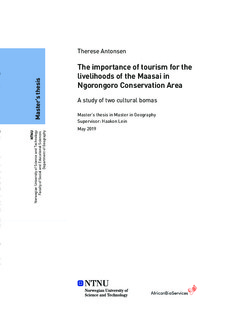| dc.contributor.advisor | Lein, Haakon | |
| dc.contributor.advisor | Weldemichel, Teklehaymanot | |
| dc.contributor.author | Antonsen, Therese | |
| dc.date.accessioned | 2019-08-25T14:07:17Z | |
| dc.date.available | 2019-08-25T14:07:17Z | |
| dc.date.issued | 2019 | |
| dc.identifier.uri | http://hdl.handle.net/11250/2610862 | |
| dc.description.abstract | Turistindustrien er en viktig del av økonomien i Tanzania og har bidratt til rask økonomisk vekst. Den har vokst til å bli en av de mest innflytelsesrike, men kontroversielle sosioøkonomiske kreftene. På grunn av sitt store omfang har den globale turismen potensiale til å påvirke og forandre hvordan mennesker bruker natur- og kulturressurser. En av de mest besøkte områdene i Tanzania er Ngorongoro Conservation Area. Området ble etablert som et flerbruksområde i 1959, og er berømt for sitt dyreliv, unike landskap, naturressursmangfold og Maasai befolkningen. Hovedformålet med området er å fremme sameksistens mellom dyreliv, turisme og lokalbefolkningen.
Turisme er et viktig alternativ til husdyrhold for Maasaiene slik at de får til å opprettholde sitt livsgrunnlag og trivsel. Kulturbasert turisme er en av aktivitetene Maasaibefolkningen i NCA engasjerer seg i. Denne typen turisme har bidratt positivt i mange områder, og har ført til utvikling av lokalsamfunn, infrastruktur, arbeidsplasser og økonomi. I denne masteroppgaven skal jeg undersøke hvordan turismen i Ngorongoro Conservation Area og menneskers arbeid i de kulturelle bomaene har påvirket Maasaibefolkningens sosioøkonomiske situasjon. Dette har jeg gjort ved å bruke teorier innen «livelihood», «wellbeing», kjønn og politisk økologi som teoretisk grunnlag. For å strukturere oppgaven og forstå hvordan det komplekse forholdet mellom Maasaibefolkningen, NCAA og turistnæringen har påvirket Maasaibefolkningens muligheter til å oppnå ønskede utfall i sitt livsgrunnlag, har jeg brukt UK Government´s Department for International Development Sustainable Livelihoods Framework.
For å generere data har jeg intervjuet 21 Maasaier som jobber i de kulturelle bomaene Seneto og Irkeepusi. I tillegg til intervjuene har jeg brukt informasjon fra en presentasjon av en ansatt ved NCAA for å oppnå forståelse av NCAAs synspunkt i temaer relatert til Maasaibefolkningen, turisme og bevaringen av området. For å undersøke hvordan Maasaibefolkningen kan videreutvikle bomaene i framtiden for å imøtekomme turistenes forventninger, samt å øke inntektene, har jeg brukt reiseskildringer fra TripAdvisor.
Resultatene viser at turisme har bidratt til utvikling innen Maasaibefolkningens lokalsamfunn i NCA, men det er noen utfordringer knyttet til enkelte lover og reguleringer. Maasaibefolkningen er blant annet nektet adgang til viktige beite- og vannområder, samt et forbud mot kultivering. Konsekvensen er at de ikke kan produsere korn eller ha nok antall dyr til å overleve kun på det. Maasaibefolkningen er derfor avhengig av matrasjoner fra NCAA og uavhengige organisasjoner for å overleve. | |
| dc.description.abstract | The tourism industry is an important part of the economy in Tanzania and has contributed to a rapid financial growth. It has grown to become one of the most powerful, but controversial socioeconomic forces. Because of the size of the global tourism industry it has potential to influence and change how people use natural and cultural resources.
One of the most visited areas in Tanzania is Ngorongoro Conservation Area. The area was established as a multiple land-use area in 1959, and is famous of its wildlife population, unique landscape, natural resources diversity, and the Maasai people. The aim with the conservation area is to secure coexistence between wildlife, tourism and the local residents. The tourism is an important alternative to livestock for the Maasai to maintain their livelihoods and wellbeing. Culture-based tourism is one of the activities the Maasai in NCA are involved in. This type of tourism has been positive in many areas as it contributes to development of communities, infrastructure, employment and economy.
In this thesis I aim to investigate how the tourism in Ngorongoro Conservation Area and people´s employment in the cultural bomas have affected the socioeconomic situation of the Maasai. This I have done by using theories within livelihood, wellbeing, gender and political ecology. To structure the thesis and to understand how the complex relationship between the Maasai, NCAA and the tourism industry is affecting the possibilities of the Maasai to achieve desired livelihood outcomes, I have used the UK Government´s Department for International Development Sustainable Livelihoods Framework. In generating data, I have interviewed 21 Maasai working in the cultural bomas of Seneto and Irkeepusi. In addition to the interviews, I have used information from a presentation given by a NCAA officer to get an understanding of their opinions of the Maasai, the tourism and the conservation. In investigating how the Maasai can develop the cultural bomas in the future to meet the expectations of the tourists and continue to increase their income, I have used travel reviews from TripAdvisor.
The results show that tourism has contributed to development within economy, education, knowledge, and empowerment of women in the Maasai communities in NCA. However, there are some challenges related to the conservation area´s policies. The Maasai are denied access to some important grazing and water areas, as well as to cultivate. As a consequence, the people cannot produce grain or keep enough livestock to survive on them alone. | |
| dc.language | eng | |
| dc.publisher | NTNU | |
| dc.title | The importance of tourism for the livelihoods of the Maasai in Ngorongoro Conservation Area. A study of two cultural bomas. | |
| dc.type | Master thesis | |
